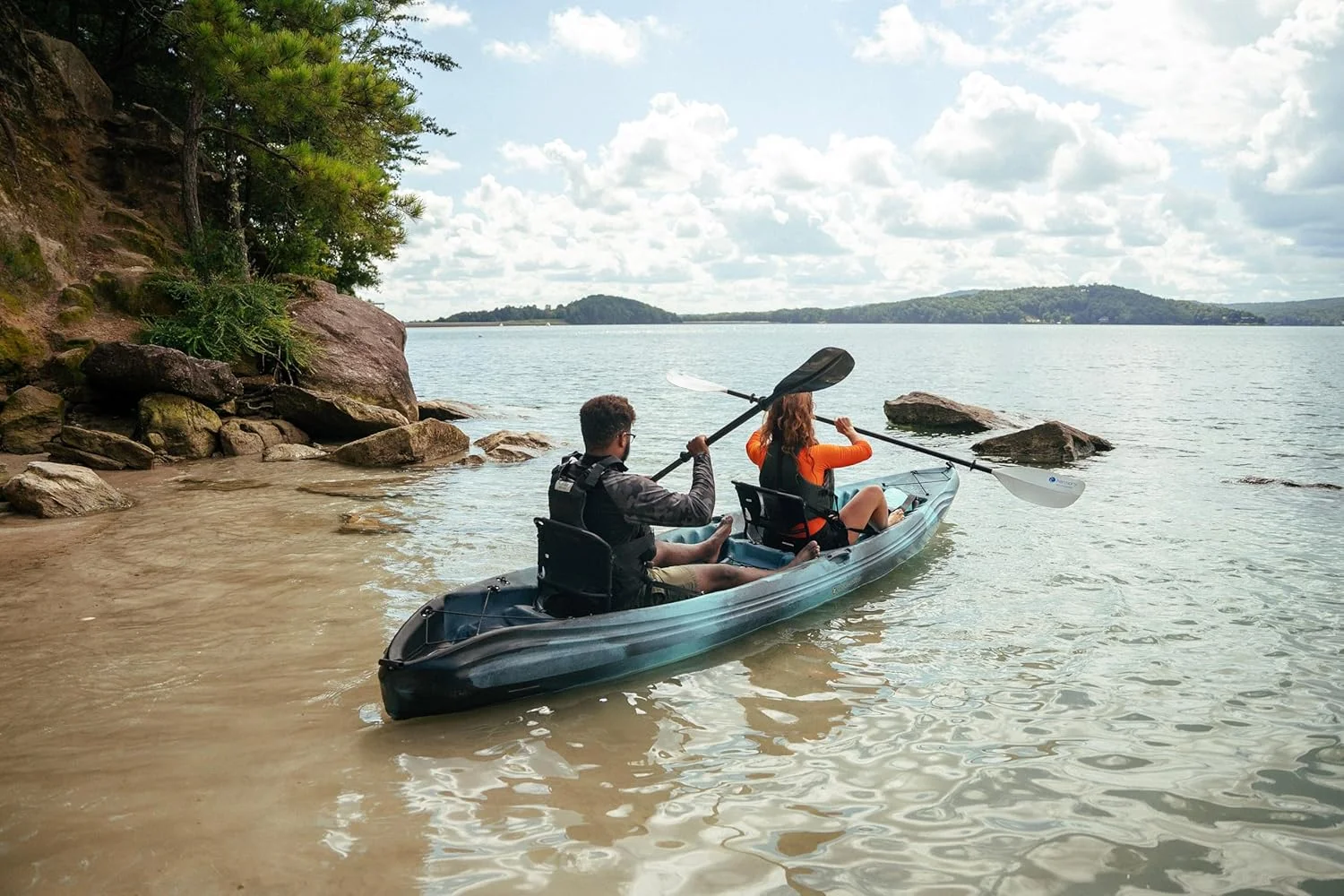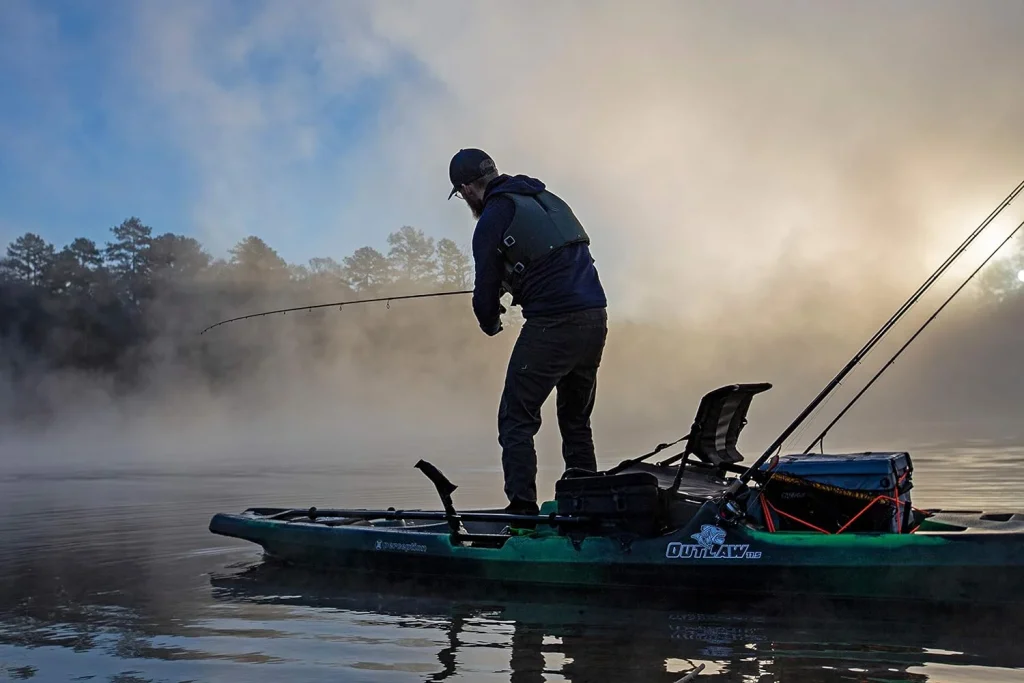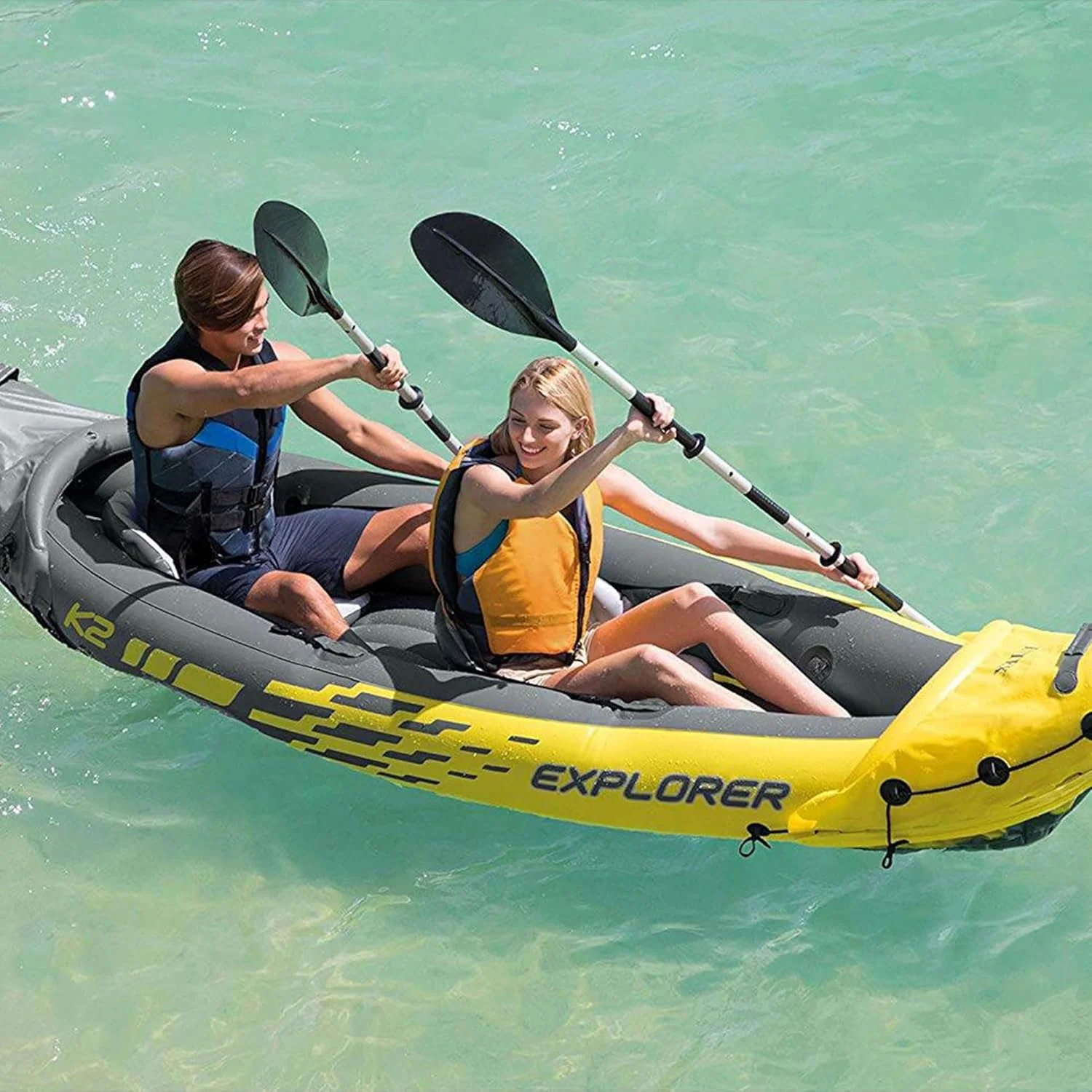Finding the best fishing kayak for 2025 isn’t just about picking the most expensive model — it’s about finding the perfect match for your fishing style, waters, and budget.
After years of hands-on testing and paddling through lakes, rivers, and open waters, I’ve come to learn that every kayak has its own strengths. But in a sea of choices, a few standout models truly redefine performance, comfort, and value.
Whether you prefer pedal drives, paddle power, motorized kayaks, or lightweight inflatables, this guide breaks down the best fishing kayaks of 2025 across every category — so you can fish smarter, not harder.
Our Top Picks

Perception Kayaks Outlaw
(For Big Guys)

385FTA FastTrack Angler
(For Two Persons)

Perception Tribe 13.5 Sit
(Under $1000)

Intex 68307EP Explorer K2
(Under $500)

Perception Crank 10
(Pedal Kayak)
Best Fishing Kayak for Big Guys
Perception Kayaks Outlaw 11.5

When it comes to the best fishing kayak for big guys, the Perception Outlaw 11.5 stands out with its stability, space, and fishing-focused features — all designed for larger paddlers.
Unmatched Stability & High Capacity
With a 425 lbs weight limit and a wide, flat hull, this kayak offers rock-solid stability whether you’re sitting or standing — ideal for confident casting and reeling.
Spacious & Smart Storage
From a large rear tankwell to bow storage and gear tracks, there’s room for all your fishing essentials without clutter.
All-Day Comfort Design
The elevated, lawn-chair-style seat provides great back support and visibility, making long trips more comfortable and easier for standing transitions.
Loaded with Fishing Features
It includes multiple rod holders, accessory mounts, and customizable options — everything an angler needs right out of the box.
Pros
Cons
Best Fishing Kayak for Two Persons
385FTA FastTrack Angler

The Sea Eagle 385FTA is a top pick for those seeking the best 2 person fishing kayak. It offers great performance, durability, and angler-friendly features in a lightweight, inflatable design.
Smooth & Stable Performance
Thanks to the NeedleKnife Keel, this kayak tracks straight and stays stable in wind and waves — perfect for smooth paddling and reaching your fishing spots faster.
Made for Anglers
With rod holders, a 36″ fish ruler, and a non-slip EVA floor, it’s fully equipped for serious fishing, while reinforced sides protect from punctures and abrasions.
Portable & Easy to Set Up
Lightweight and inflatable, the 385FTA fits in your trunk and inflates in minutes — no trailer or ramp needed, making it ideal for on-the-go anglers.
Comfortable for Two
Tall-back foam seats with adjustable straps provide all-day comfort and support. There’s also space for gear, keeping everything organized and within reach.
Pros
Cons
Best Fishing Kayak Under $1000
Perception Tribe 13.5 Sit on Top Tandem Kayak

When I was looking for the best fishing kayaks under 1000 dollars, the Perception Tribe 13.5 instantly stood out. Whether I’m out for a relaxing paddle or a full day of fishing, this tandem sit-on-top kayak gives me everything I need — comfort, storage, and serious durability.
Comfort That Goes the Distance
One thing I really appreciate is how comfortable it is. The adjustable seatbacks and cushioned seat pans make long trips easy on my back, and the molded thigh areas give extra support when paddling for hours.
Plenty of Room for My Gear
I usually carry quite a bit when I go fishing, and this kayak handles it like a champ. With large tank wells in the front and back and two center hatches, I have space for all my essentials — and they stay secure, dry, and within reach. Plus, the scupper holes keep water from pooling, which I love.
Tough Enough for Any Adventure
This thing is built like a tank. Its one-piece roto-molded design handles bumps, UV rays, and rough conditions without a problem. With a 500 lbs capacity, I can bring a friend and plenty of gear — and still feel stable on lakes, rivers, or even light coastal waves.
My Takeaway
If you’re after the best fishing kayak under 1000, I can confidently say the Perception Tribe 13.5 is worth it. It’s reliable, roomy, and comfortable — a great all-around kayak that doesn’t break the bank.
Pros
Cons
Best Fishing Kayak Under $500
Intex 68307EP Explorer K2

A few days ago, Adam from our team tested out the Intex Explorer K2 Kayak, and after a couple of fishing trips, he was completely sold on it. His hands-on experience left such a strong impression that we didn’t hesitate to rank it as our #1 pick for the best budget fishing kayak in 2025.
Lightweight, Portable & Easy to Set Up
Adam’s first comment? “It’s incredibly easy to carry and set up.” Being an inflatable 2-person kayak, it folds up small and fits in a car trunk — no trailer or roof rack needed. It comes with 86-inch aluminum oars and a high-output pump, so it’s water-ready in just a few minutes.
Durable Build & Smart Design
Made from tough vinyl material, the K2 held up well in different weather conditions. Adam also liked the bright yellow color, which boosts visibility and adds a layer of safety — especially useful when fishing in open water or low-light areas.
Simple Features That Make a Big Difference
Adam loved the Boston valve system for quick inflation and deflation. He said it saved him a ton of time when he was eager to hit the water or pack up afterward.
He also appreciated the adjustable inflatable seats with backrests, which offered great comfort even on longer fishing trips — no back pain, no fuss.
Stable & Smooth Performance
Despite being inflatable, Adam found the K2 surprisingly stable. Its I-beam floor and high-buoyancy side chambers kept the kayak balanced, even while casting or shifting seats.
The removable skeg was another win — it helped with tracking and steering, especially in mild currents.
Roomy Enough for Two and Your Gear
With a 400 lb capacity, this kayak fits two adults and a reasonable amount of fishing gear comfortably. While it’s not built for heavy-duty storage, Adam had no trouble carrying essentials like a tackle box, rods, and snacks without feeling cramped.
Final Thoughts from Adam
“If you want a solid fishing kayak that’s super affordable, lightweight, and easy to manage — the Intex Explorer K2 is a no-brainer. For under $500, it delivers way more than expected.
Pros
Cons
Best Fishing Kayak with Pedals
Perception Crank 10 Pedal Kayak

I’ve tried quite a few kayaks over the years, but the Perception Crank 10 really surprised me — in the best way possible. If you’re looking for the best budget fishing kayak with pedals, this one definitely deserves a spot at the top of your list.
Smooth Pedal Drive That Keeps Your Hands Free
The first thing I noticed was how smooth the pedal drive felt. I was able to move forward and reverse without touching a paddle — which meant I had both hands free to focus on fishing. Covering water became so much easier and way less tiring, especially when chasing fish in wider areas.
Comfortable Seat That Actually Supports Your Back
One of the biggest wins for me was the lawn-chair-style seat. I spent several hours on the water, and not once did I feel sore or cramped. The mesh seat kept things cool even under the sun, and the adjustable position helped me find the sweet spot for pedaling comfortably.
Lightweight but Rock Solid on the Water
I expected a pedal kayak to be heavy, but the Crank 10 is surprisingly manageable. At just 87 lbs, I could load and unload it myself. On the water, it felt super stable — even when I shifted around or leaned a bit while casting. With a 350 lb capacity, I had plenty of room for my tackle, snacks, and extra gear.
Final Thoughts
If you’re like me and want a reliable, easy-to-use fishing kayak with pedals without spending a fortune, the Perception Crank 10 is a no-brainer. It’s fast, stable, and comfortable — everything I need for a full day of fishing.
Pros
Cons
Fishing Kayak Buyer’s Guide (2025)
Finding the best fishing kayak isn’t just about picking the most expensive model — it’s about choosing the right kayak for your fishing style, water conditions, and personal needs. Whether you’re casting in calm lakes, navigating narrow rivers, or exploring coastal bays, this guide will help you make a smart and satisfying purchase.
🎯 1. Kayak Type: Sit-On-Top vs Sit-In
- Sit-on-top kayaks are ideal for fishing. They offer better mobility, stability, and storage space, and are easier to get in and out of — especially if you’re wearing waders or fishing gear.
- Sit-in kayaks offer more protection from the elements, making them better for colder conditions or longer paddles, but they limit movement.
✅ Top choice for anglers: Sit-on-top kayak.
🚴♂️ 2. Propulsion Method: Paddle, Pedal, or Motor
- Paddle kayaks are budget-friendly and lightweight — perfect for small water bodies.
- Pedal kayaks (like the Perception Crank 10) offer hands-free operation, ideal for casting and trolling.
- Motorized fishing kayaks provide power and speed but are heavier and require maintenance.
💡 Best for hands-free fishing: Pedal drive system.
⚖️ 3. Stability & Weight Capacity
If you’re a big guy, or you like standing while casting, prioritize kayak stability. Look for wider hulls and a flat deck surface. Also, check the weight capacity — typically between 300 to 500 lbs — to ensure it supports both you and your gear.
📦 4. Storage Options
A good fishing kayak should have:
- Rear tankwells for crates or coolers
- Dry storage hatches for valuables
- Molded-in or mounted rod holders
- Gear tracks for fish finders, GoPro mounts, and other accessories
🔧 Customization tip: Look for kayaks with universal accessory rails.
🪑 5. Seat Comfort & Adjustability
If you plan to spend hours on the water, a good kayak seat is non-negotiable. Go for:
- Elevated lawn-chair-style seating
- Mesh fabric for breathability
- Adjustable backrest and foot pegs
🎣 Long sessions = Happy back.
🌊 6. Water Type Compatibility
Match your kayak to the water:
- Lakes & Ponds: Lightweight, stable kayaks
- Rivers & Streams: Agile, shorter kayaks
- Ocean or Bays: Longer, seaworthy models with better tracking
🌤️ Tip: Removable skegs help improve tracking in choppy water.
💰 7. Price Range & Value
Fishing kayaks range from $300 to $3,000+ depending on features. For most beginners or casual anglers:
- Under $500: Great inflatables like Intex Explorer K2
- $500–$1,000: Solid entry-level models with decent storage and comfort
- $1,000+: Pedal drive, better stability, and pro-grade features
💡 Consider it an investment — better comfort = longer, more enjoyable trips.
🧰 8. Key Accessories to Look For
- Rod holders (flush-mount or swivel)
- Fish finder compatibility
- Anchor trolley system
- Paddle parks and leashes
- Tackle box storage
- Cooler mounts
🧩 Tip: More built-in features = less aftermarket spending.
🛡️ 9. Build Material & Durability
- Polyethylene (PE): Tough, UV-resistant, and most common
- PVC & Drop-Stitch Inflatables: Lightweight and portable (e.g., Sea Eagle 385FTA)
- Composite/Carbon Fiber: Lightweight and strong but expensive
🏋️♂️ Choose material based on use-case and transportability.
✅ Final Thoughts
Choosing the best fishing kayak depends on your needs, budget, and where you fish. Don’t fall for hype — instead, consider:
- Your body size and comfort needs
- Preferred fishing locations
- Required storage and features
- How much effort you’re willing to put into transport and setup
A well-chosen kayak is not just a fishing tool — it’s your mobile fishing base.
